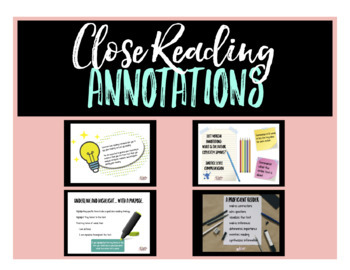Close Reading, Metacognition, and Text Annotations Teacher Presentation
- Google Drive™ folder

What educators are saying
Also included in
- Here are some of our best lessons for directly teaching reading skills for both fiction and non-fiction, plus some review activities and games for students to keep practicing their reading skills.Price $88.00Original Price $132.00Save $44.00
Description
Introducing our comprehensive introductory mini-lesson designed specifically for middle school English teachers like you, focusing on close reading, metacognition, and effective text annotation.
What's Inside:
Our meticulously crafted non-editable presentation comes in Google Slides, Canva, and PDF formats, covering all the essential components of a successful lesson: from setting the stage with an anticipatory set to providing direct instruction, guiding practice, conducting assessment, and fostering reflection.
Why It Works:
Versatile and adaptable, this mini-lesson is suitable for any text, whether fiction or nonfiction. Encourage your students to jot down notes in their composition books during the lesson to retain crucial information for future reference. We've even included a selection of recommended reading texts that have proven to be hits in our own classrooms.
Why It's Different:
Unlike traditional lessons accompanied by worksheets, we empower students to take ownership of their learning journey by encouraging personalized note-taking styles. This not only eliminates the need for endless copies but also cultivates stronger reading skills as students actively annotate the text, making connections and deepening comprehension along the way.
What You'll Receive:
Two Google Slide presentations (Original and Updated versions)
Canva Presentation Link
Two PDFs of the presentations for easy access and sharing with students
Experience the Change:
We're confident that our approach to close reading will lead to lasting improvements in your students' reading abilities, setting them on the path to becoming confident and proficient readers.
Happy Teaching!






